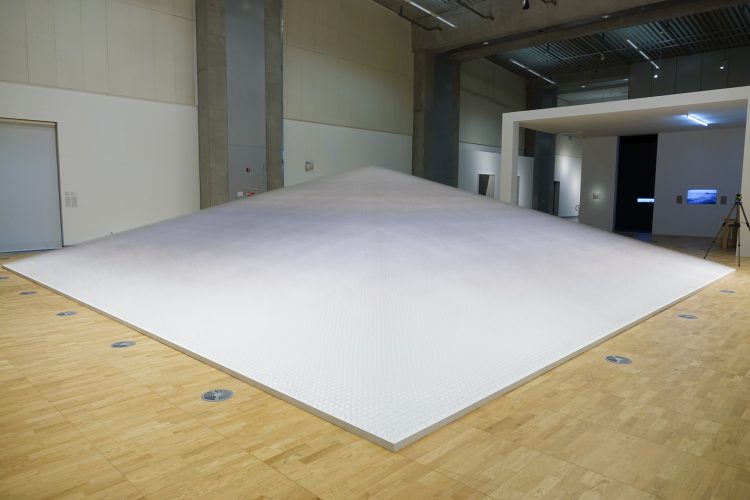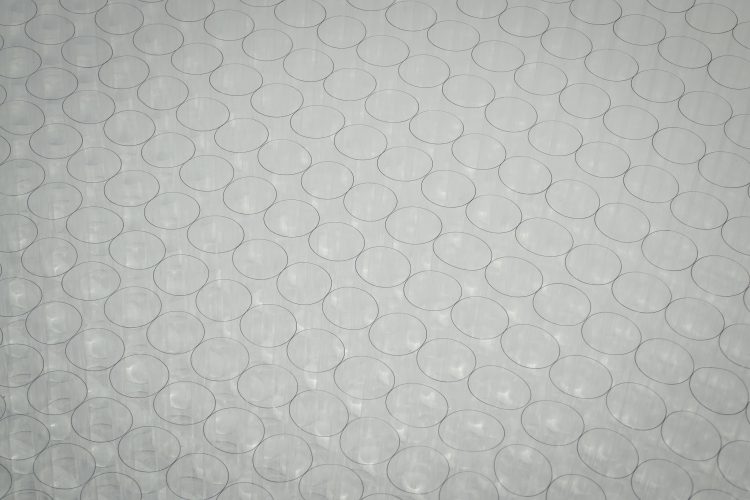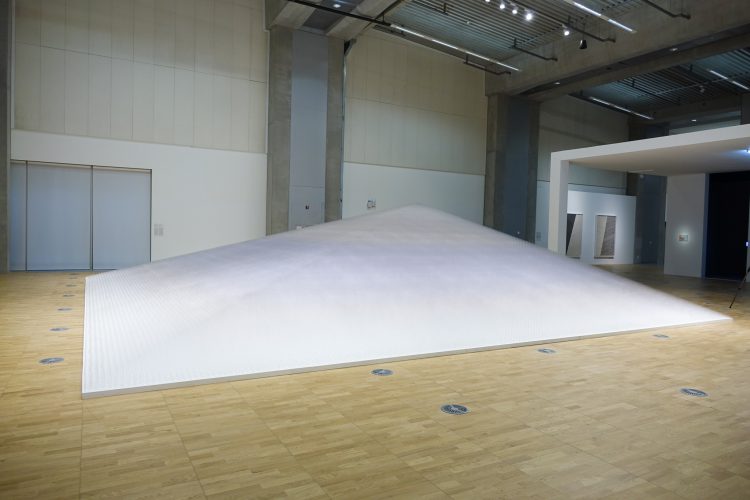Interview with Tara Donovan
31 July 2018
Via email
Can you tell us a little about your work Untitled? Why are you interested in plastic tubes? Why did you choose a bisected pyramid form for this work?
My project takes the form of a monumental installation that resulted from some of my experiments with the material condition of transparency. The installation took the form of a pyramidal cross-section as a way to define a spatial volume that approached the scale of architecture in relation to the human body. Tens of thousands of clear plastic tubes normally used for commercial product packaging were cut to precise lengths along a scale from 2 inches to 8 feet and assembled in tiered sections that come together into a 33-foot square footprint. Situated vertically in a grid pattern upon a square horizontal plane, the assembled tubes delineate a three-dimensional mathematic rendering of a geometric volume. Playing with the superimposition of physical forms, the individual tubes can overlap without the optical destruction of each other, while at the same time exploiting properties of the material that only reveal themselves in accumulation.
This sculptural work of yours is very architectonic—the pyramid being one of the great feats of architectural landscape. Do you make a distinction between sculpture and architecture form?
I have always maintained a strong dialogue with architects (my husband is one). I think they gravitate toward my work because of my use of unorthodox materials to develop abstract forms and structures. I don’t, however, make any attempts to collapse the distinction between sculpture and architecture in my work. My works uses the concept of the ‘field’ or ‘screen’ as a means to exploit dynamic visual phenomena in an attempt to transcend materiality in order to privilege the experiential. My work is intentionally open-ended and unspecific so that viewers can develop their own individual associations to it. I think even the most radical architecture has a specificity of purpose and function that my work never approaches.
The work emits a purplish light—why is this?
The cylindrical refraction of light performed by each clear plastic tube is amplified by the simultaneity of perception that transparency allows. Light becomes the primary articulating element of the structure’s volume, which emanates beyond and obscures the material membrane of each tube, resulting in an optical blur as viewers negotiate the space around the structure. The plastic itself exhibits a lavender graphite color when layered visually, which takes on an atmospheric effect within the overall volume as a type of diffused grey scale step-gradient hovering in three-dimensions. Color is what I refer to as a ‘fugitive’ element in my work in that it often only reveals itself upon accumulation. While the tubes individually appear clear, the purplish color is a result of inconsistencies in the manufacturing process.
It is hard to avoid the question about plastics and the environment, especially when we are confronted with a 33ft plastic structure. What is your response to those who are critical of your use of this material?
My work has more or less always been considered in relation to consumerism since the beginning, but I think it’s incredibly interesting that my work is only recently being considered in relation to concepts of geological time and issues such as global warming and environmental hazards. I currently have work in Hyperobjects at Ballroom Marfa in Marfa, Texas, which is a group exhibition that attempts to explore the overwhelming scale of today’s ecological crisis. My work has also recently been reconsidered within the concept of the ‘anthropocene’ as a new phase of geological time identified with the imprint of human development and waste. I enthusiastically welcome these new interpretations as they allow my work to function within the long-term as a type of archaeological object or historical document of a particular manifestation of human values that have changed. I think there is no doubt that within my lifetime, we will see a global ban on the use of plastic drinking straws. While this will make any future iterations of Haze much more challenging, I am very happy for the work to be considered in relation to these necessary changes in consumption patterns.
타라 도노반과의 인터뷰
2018 년 7 월 31 일
이메일을 통해
작가님의 <무제> 에 대해서 간략히 설명해 주실 수 있을까요? 왜 플라스틱 관에 관심을 갖게 되셨나요? 이등분 피라미드 형태를 고르게 된 이유는 무엇입니까?
이전에 소재의 투명성에 대한 실험을 몇 번 진행했던 적이 있는데, 그 결과물을 기념비적 설치 작업 형태로 제 프로젝트에 사용하게 되었습니다. 설치물은 피라미드 형태의 횡단면 모양으로 공간의 부피를 측정하여 사람과 비교했을 때 건축물 정도의 규모입니다. 평소 상품 포장에 쓰이는 투명 플라스틱 관 수만 개를 2인치부터 8피트까지 규격을 정확히 맞추어 잘라낸 후 섹션 별로 33 제곱피트의 영역에 나열합니다. 관들은 정사각형의 수평면에 세로로 격자 패턴을 그리며 세워져 기하학적 구조의 3차원 수학적 해석을 표현합니다. 각각의 투명 관은 물리적 형태의 중첩을 활용하기 때문에 어떠한 시각적 파괴 없이 겹쳐질 수 있으며 축적된 상태로만 형태를 드러내는 소재의 성질을 이용합니다.
피라미드 구조물이 건축에서 큰 업적을 차지하는데요, 이 조각 자체가 굉장히 건축학적이네요. 조각과 건축적 형태에 구분을 두고 작업하시나요?
저는 항상 건축가들과 많은 대화를 나눠왔습니다 (제 남편이 건축가이기도 하고요). 특이한 소재들로 추상적 형태와 구조를 만드는 과정 때문에 건축가들이 제 작품에 관심을 갖는 것 아닐까 싶습니다. 하지만 저는 작품에서 조각과 건축의 구분을 무너뜨리려고 하지는 않습니다. 저는 ‘장(場)’ ‘화면’ 등의 컨셉트를 역동적인 시각적 현상을 활용하기 위해 사용합니다. 경험을 우선시하기 위해 물질성을 초월하려는 시도입니다. 제 작품은 의도적으로 불특정하고 해답이 없기에 관람자들 스스로가 작품과 개인적 연관성을 만들어낼 수 있습니다. 가장 과격하고 극단적인 건축물조차 제 작품에서는 찾을 수 없는 특정성과 목적을 가지고 있다고 생각합니다.
작품에서 보라색 빛이 뿜어져 나오는데, 왜 이렇죠?
투명 플라스틱 관들이 각자 원통의 형태로 빛을 굴절시키면, 투명성으로 인한 인지의 동시성이 굴절을 증폭시킵니다. 여기서 빛은 구조물의 부피를 이어주는 가장 기본적인 물질이 됩니다. 구조물 너머로 뿜어져 나오는 빛들이 각각의 관을 둘러싼 소재의 막을 흐리고, 관람객들이 구조물 주위의 공간을 이해하는 과정에서 시야를 뿌옇게 만듭니다. 플라스틱들은 겹쳐져 있을 때 연보라 흑연의 색으로 보이는데, 입체면에서 일렁이는 회색 빛이 그라데이션을 이루며 뿜어져 나와 전체 구조물의 분위기를 형성합니다. 색채는 주로 모여 있을 때만 모습을 드러내는 탓에 제 작품에서 ‘도피적인’ 요소로 작용합니다. 플라스틱 관들은 각자 있을 땐 투명하지만, 생산 과정에서의 어긋난 부분들 탓에 보라색이 나타납니다.
33피트짜리 플라스틱 구조물을 앞에 두고 플라스틱과 환경에 관한 질문을 안 할 수 없는데요, 플라스틱 사용에 대해 비판적인 사람들에게 어떻게 답해 주실 수 있나요?
이 작품은 처음부터 거의 항상 소비지상주의과 연관지어 해설되었습니다. 그런데 흥미롭게도 최근에 와서야 지구 온난화, 환경 유해물 등의 지질학적 시간과 주제에 연관지어지네요. 작품은 현재 미국 텍사스 마르파의 마르파 연회장에서 열리는 하이퍼 오브젝트에 전시되어 있습니다. 하이퍼 오브젝트는 오늘날의 대규모 생태학적 위기를 탐구하기 위한 단체전입니다. 최근 ‘인류세 (인류의 발전 및 낭비에 대한 각인과 함께 규정지어지는 새로운 지질학적 시기)’ 라는 개념으로도 재해석되었습니다. 저는 제 작품에 대한 새로운 해석들을 아주 열렬히 환영합니다. 작품이 길게 봐서 고고학적 유물이나, 변화한 인류의 가치의 특정 징후를 기록하는 역사적 수단으로 쓰일 수도 있으니까요. 분명 제가 죽기 전에 플라스틱 빨대 사용이 전세계적으로 금지될 거라고 믿습니다. 미래에 헤이즈 (먼지, 스모그 및 여러 다른 미세 물질들로 대기가 흐려지는 현상) 처리가 좀 골치아파지긴 하겠지만, 제 작품이 이러한 소비 패턴에 있어서 필수적인 변화들과 연관지어지는 건 아주 좋게 생각합니다.






